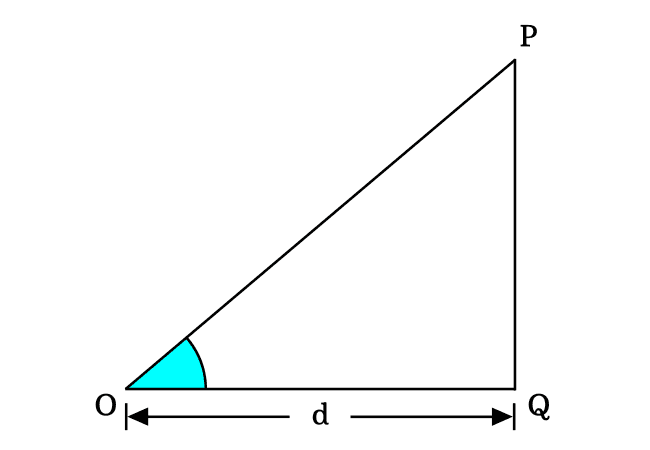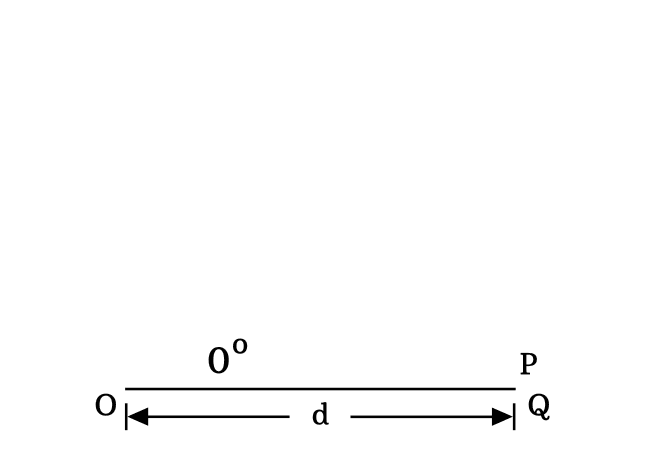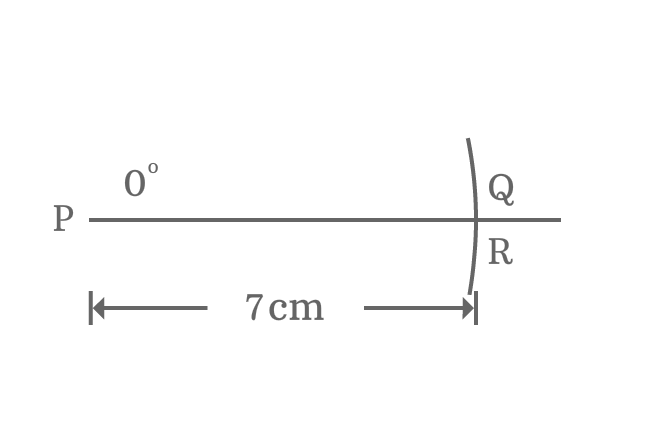Properties of 0° Right triangle
There are three fundamental properties of a right triangle when its angle is zero degrees.
- The length of opposite side is zero.
- The lengths of adjacent side and hypotenuse are equal.
- The angle of right angled triangle is zero and the other two angles are right angles.
Theorem
Geometrically, it is not possible to construct a zero degrees right triangle understandably but it can be imagined theoretically.

$\Delta POQ$ is a right triangle basically and the $\angle POQ$ represents the angle of this triangle. If the angle $POQ$ is equal to zero, then the triangle $POQ$ is called a zero degrees right angled triangle.
In this triangle, $\angle POQ$, $\angle OPQ$ and $\angle OQP$ are three angles but the $\angle POQ \,=\, 0^°$ and $\angle OQP \,=\, 90^°$
According to the angle sum property of a triangle, the sum of three interior angles in a triangle is $180^°$.
$\angle POQ + \angle OPQ + \angle OQP = 180^°$
$\implies 0^° + \angle OPQ + 90^° = 180^°$
$\implies \angle OPQ = 180^° – 90^°$
$\,\,\, \therefore \,\,\,\,\,\, \angle OPQ = 90^°$
Theoretically, it is proved that the two angles in a right angles are right angles when the angle of a right angled triangle is zero degrees.

Assume that the length of adjacent side of this triangle is denoted by $d$.
The zero angle is possible geometrically in a right triangle when the length of opposite side is equal to zero.
$Length \, of \, Opposite \, side$ $\,=\,$ $0$
$\implies$ $PQ$ $\,=\,$ $0$
Due to zero length of opposite side, the length of hypotenuse is absolutely equal to the length of hypotenuse. So, remember this property when angle of right triangle is zero.
$\,\,\, \therefore \,\,\,\,\,\,$ $Length \, of \, Adjacent \, side$ $\,=\,$ $Length \, of \, Hypotenuse$ $\,=\,$ $d$
Proof
A right triangle is required to construct with zero angle for proving all its properties geometrically.

- Draw a horizontal line from point $\small P$ in a plane.
- Identify zero angle from point $\small P$ and draw zero angle line from point $\small P$ but it appears on horizontal line.
- Set compass to a length (for example $7 \, cm$) by a ruler. Now, draw an arc on zero angle line and they are intersected at point $\small Q$.
- It’s not possible to draw a perpendicular line from point $\small Q$ to horizontal line because they both lie on same line. So, assume a perpendicular line is drawn from point $\small Q$ to horizontal line and it intersects the horizontal line at point $\small R$.
A right triangle ($\Delta RPQ$) is constructed with zero degrees angle. Now, it is time to study the properties of right angled triangle when its angle is zero.

- $\small \overline{QR}$ is opposite side (or perpendicular). There is no distance between points $\small Q$ and $\small R$. So, the length of opposite side is zero.
- $\small \overline{PQ}$ is hypotenuse. It is $7 \, cm$ in this case.
- $\small \overline{PR}$ is adjacent side (or base). Due to zero length of opposite side, the length of adjacent side is equal to length of hypotenuse exactly. So, the length of adjacent side $\small \overline{PR}$ is also $7 \, cm$.
Therefore, it is proved that the length of opposite side is zero and the length of adjacent side is equal to length of hypotenuse when angle of right triangle is zero.
- There is no angle between sides $\small \overline{PR}$ and $\small \overline{PQ}$. So, the angle of right triangle is zero. It means $\small \angle RPQ = 0^°$.
- $\small \overline{QR}$ is a perpendicular line to side $\small \overline{PR}$ at point $\small R$. So, $\small \angle PRQ = 90^°$, which means second angle of right triangle is a right angle.
- The length of perpendicular line ($\small \overline{QR}$) (known as opposite side) is zero. The hypotenuse and adjacent side are appeared in horizontal line position. Therefore, $\small \angle PQR = 90^°$. In other words, the third angle of right triangle is also a right angle.
